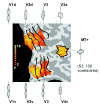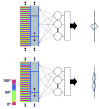Decoding the visual and subjective contents of the human brain
- PMID: 15852014
- PMCID: PMC1808230
- DOI: 10.1038/nn1444
Decoding the visual and subjective contents of the human brain
Abstract
The potential for human neuroimaging to read out the detailed contents of a person's mental state has yet to be fully explored. We investigated whether the perception of edge orientation, a fundamental visual feature, can be decoded from human brain activity measured with functional magnetic resonance imaging (fMRI). Using statistical algorithms to classify brain states, we found that ensemble fMRI signals in early visual areas could reliably predict on individual trials which of eight stimulus orientations the subject was seeing. Moreover, when subjects had to attend to one of two overlapping orthogonal gratings, feature-based attention strongly biased ensemble activity toward the attended orientation. These results demonstrate that fMRI activity patterns in early visual areas, including primary visual cortex (V1), contain detailed orientation information that can reliably predict subjective perception. Our approach provides a framework for the readout of fine-tuned representations in the human brain and their subjective contents.
Conflict of interest statement
Figures







Comment in
-
Imaging orientation selectivity: decoding conscious perception in V1.Nat Neurosci. 2005 May;8(5):541-2. doi: 10.1038/nn0505-541. Nat Neurosci. 2005. PMID: 15856054 No abstract available.
References
-
- Paradiso MA. A theory for the use of visual orientation information which exploits the columnar structure of striate cortex. Biol Cybern. 1988;58:35–49. - PubMed
Publication types
MeSH terms
Grants and funding
LinkOut - more resources
Full Text Sources
Other Literature Sources
Medical
Molecular Biology Databases
